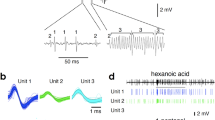Summary
-
1.
Small octopuses,Octopus vulgaris, (150 g) were blinded by section of the optic nerves to eliminate the use of visual cues. The animals were placed in a transparent Plexiglas tube (9 cm × 60 cm) that was continuously perfused with fresh sea water, and their behaviour was observed following the introduction of single organic compounds at known concentrations (Fig. 1).
-
2.
Alterations in the ventilation rhythm (puffing) were elicited by glutamic acid 10−4 mol/l, glycine 10−4 mol/l and adenosine 5′-monophosphate (AMP) 10−7 mol/l. Arm waving and the forced expulsion of water through the siphon (blowing) were also observed with the same stimuli. Sea water controls showed significantly lower rates of response (Fig. 2).
-
3.
Locomotion was elicited by glutamic acid 10−4 mol/l, glycine 10−3 mol/l, and AMP 10−6 mol/l (Fig. 2). The direction of locomotion was invariably upstream (51 trials). Because the stimuli were introduced to either the right or the left of a partition which bisected the upper third of the experimental tube, it was possible to evaluate the animal's perception of stimulus location. Two criteria were used: the entry of an animal into the space at either side of the partition, and the initial distribution of an animal's probing arms on the two sides (Table 2). In both cases, the results indicate an orientation towards the stimulus source, i.e. chemotaxis.
-
4.
The frequency of responding, for all types of response, decreased from the first to the last trial in each testing session (Fig. 3). Sensitization was demonstrated by giving theOctopus a small piece of fish between stimulus trials (Fig. 4).
-
5.
The suckers on the arms of theOctopus are believed to be the sensory structures responsible for the observed behaviours. The chemical sense may be an important adjunct to vision in the search for food under natural conditions.
Similar content being viewed by others
Abbreviations
- AMP :
-
adenosine 5′-monophosphate
References
Ache BW (1982) Chemoreception and thermoreception. In: Atwood HL, Sandeman DC (eds) The biology of Crustacea, vol 3. Academic Press, New York, pp 369–398
Boyle PR (1983) Ventilation rate and arousal in the octopus. J Exp Mar Bioi Ecol 69:129–136
Carr WES, Thompson HW (1983) Adenosine 5′-monophosphate, an internal regulatory agent, is a potent chemoattractant for a marine shrimp. J Comp Physiol 153:47–53
Graziadei P (1962) Receptors in the suckers ofOctopus. Nature 195:55–59
Graziadei P (1964) Electron microscopy of some primary receptors in the sucker ofOctopus vulgaris. Z Zellforsch 64:510–522
Packard A (1972) Cephalopods and fish: the limits of convergence. Biol Rev 47:241–307
Schmitt B, Ache B (1979) Olfaction: responses of a decapod crustacean are enhanced by flicking. Science 205:204–206
Wells MJ (1963) Taste by touch: some experiments withOctopus. J Exp Biol 40:187–193
Wells MJ (1964) Tactile discrimination of surface curvature and shape by octopuses. J Exp Biol 41:435–445
Wells MJ (1978)Octopus, physiology and behaviour of an advanced invertebrate. Chapman and Hall, London
Wells MJ, Wells J (1956) Tactile discrimination and the behaviour of blindOctopus. Pubbl Staz Zool Napoli 28:94–126
Wells MJ, Freeman NH, Ashburner M (1965) Some experiments on the chemotactile sense of octopuses. J Exp Biol 43:553–563
Woodhams PL, Messenger JB (1974) A note on the ultrastructure of theOctopus olfactory organ. Cell Tissue Res 152:253–258
Zimmer-Faust RK, Case JF (1983) A proposed dual role of odor in foraging by the California spiny lobster,Panulirus interruptus (Randall). Biol Bull 164:341–353
Author information
Authors and Affiliations
Rights and permissions
About this article
Cite this article
Chase, R., Wells, M.J. Chemotactic behaviour inOctopus . J. Comp. Physiol. 158, 375–381 (1986). https://doi.org/10.1007/BF00603621
Accepted:
Issue Date:
DOI: https://doi.org/10.1007/BF00603621




